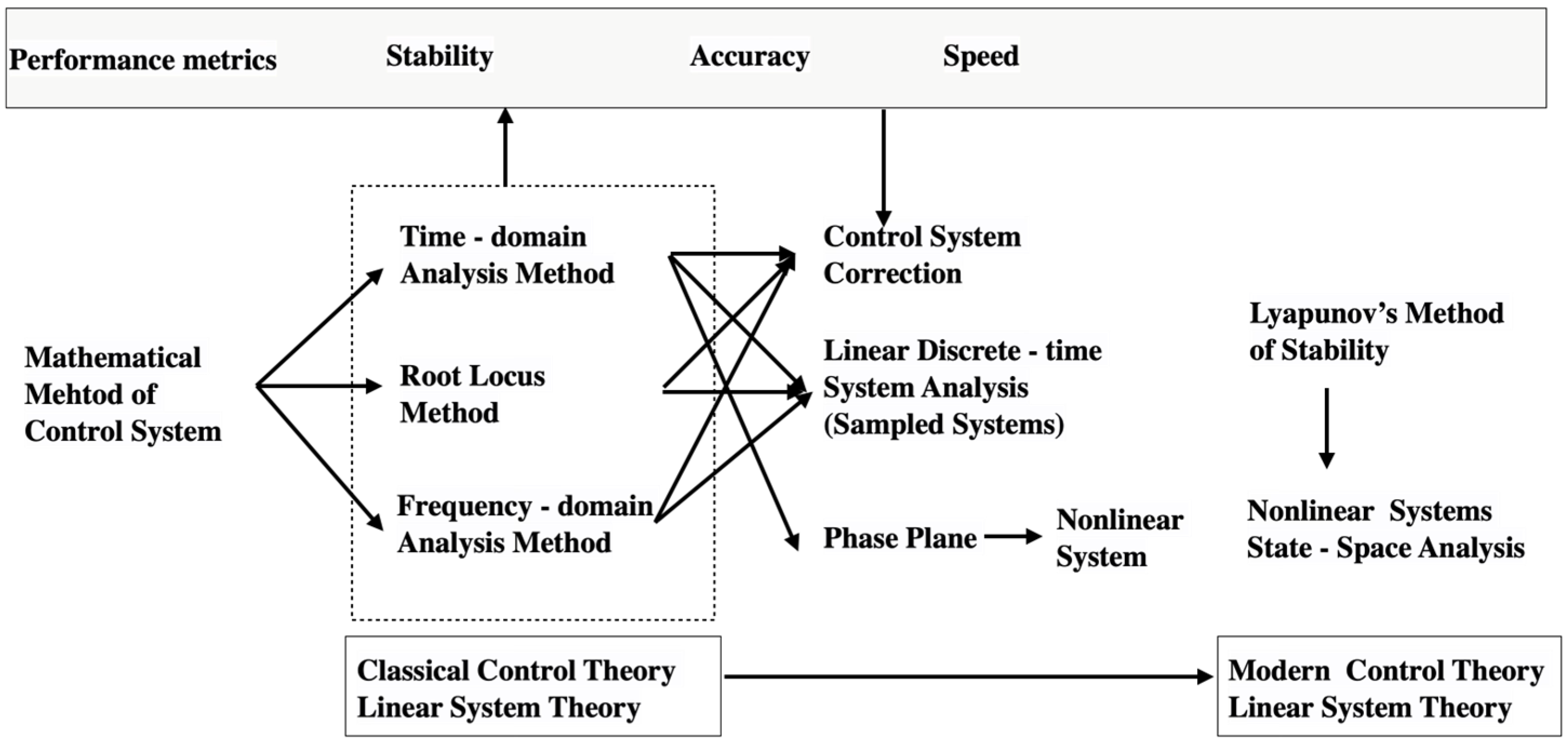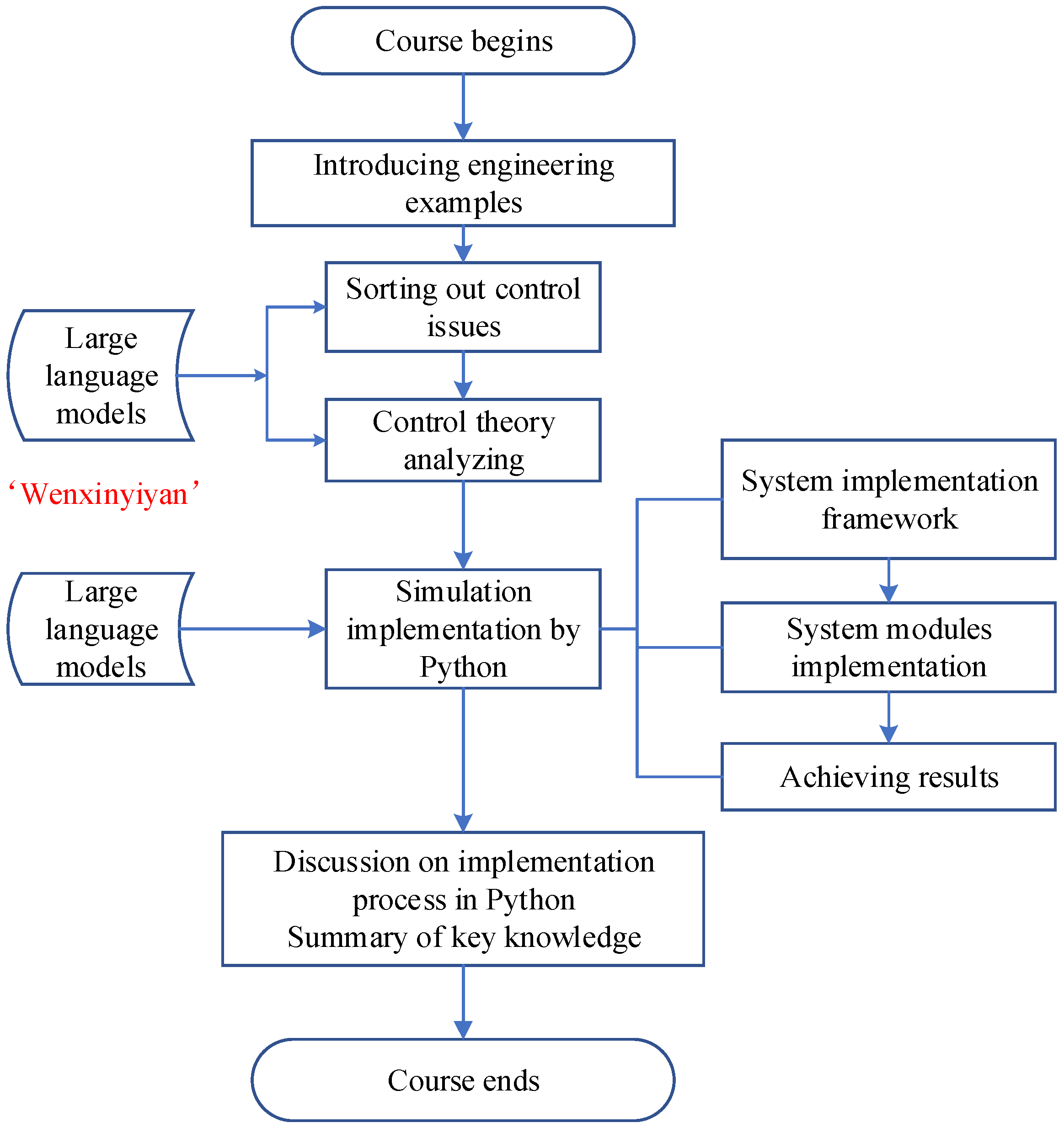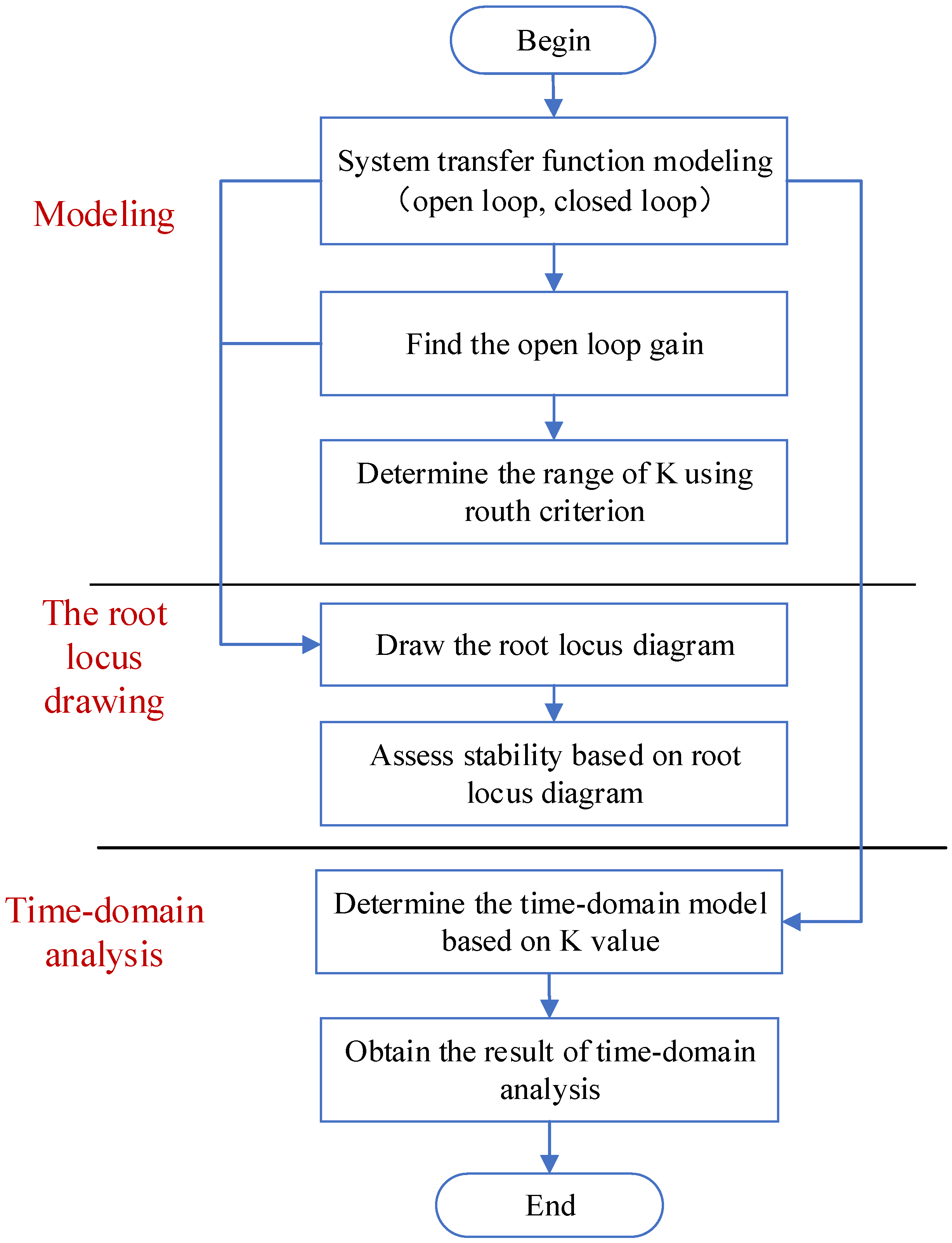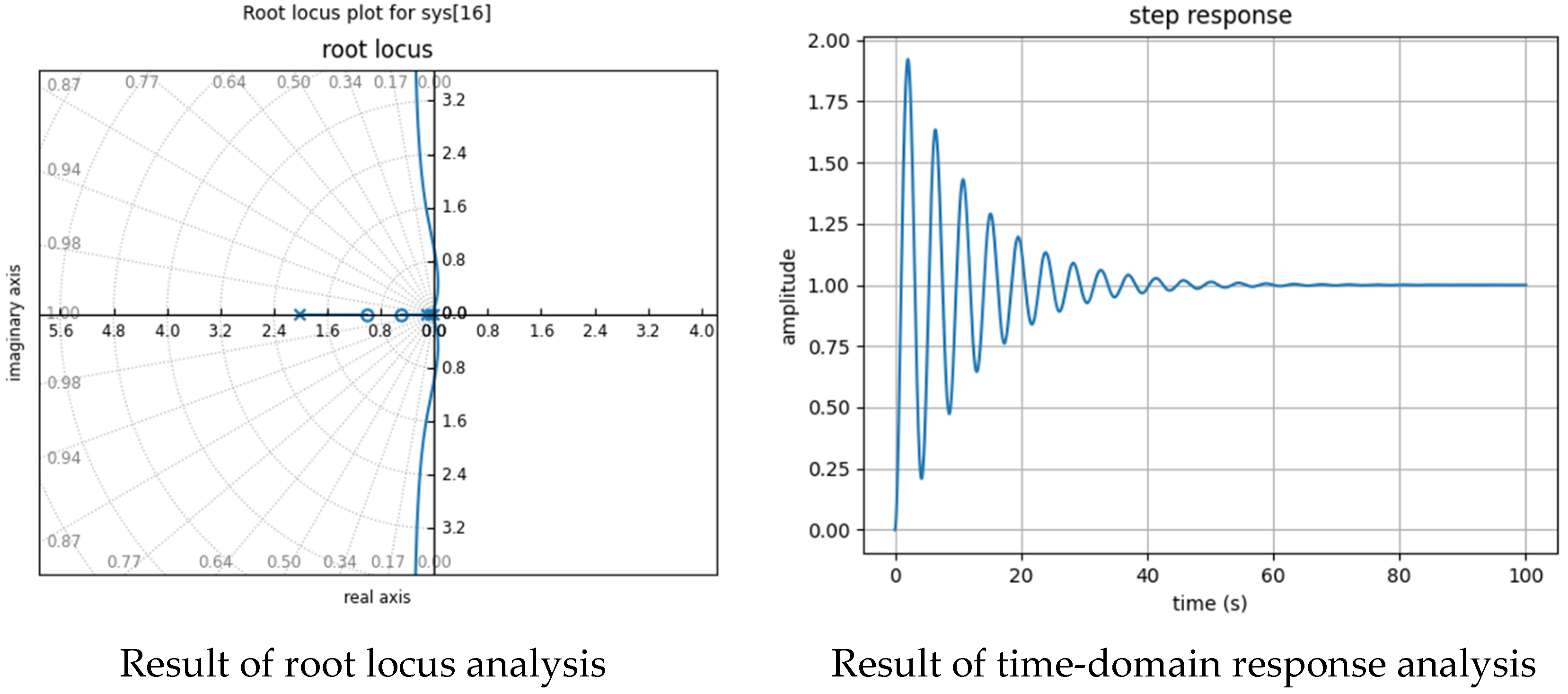Large Language Model-Integrated Teaching Practices in Courses on Python and Automatic Control Principles †
Abstract
1. Introduction
2. Traditional Teaching Mode
2.1. Curriculum System of Principles of Automatic Control
2.2. Course Characteristics
- The prerequisite courses are theoretical, extensive in content, and challenging in difficulty. Besides mathematical courses such as advanced mathematics, complex variable functions, and linear algebra, the prerequisite courses include college physics, thermodynamics, circuit theory, and electronics technology. From the perspective of application, establishing mathematical models of application systems requires fundamental knowledge across various disciplines. This course has numerous knowledge points and obscure content. Based on the feedback from students and teachers, it is difficult to ensure teaching quality solely through classroom instruction.
- The course is overly abstract, with inadequate practical components. Although the course originates from practical applications and aims to contribute back to them, many existing textbooks do not adequately address the integration of theory with practice. The majority of experiments are focused on theoretical verification, which directly affects the cultivation of students’ engineering practice abilities.
- Currently, the principles of the automatic control course offered by various universities are primarily credited with 3, 3.5, or 4 credits. Due to the heavy teaching load and primary reliance on classroom instruction, there is a low intersection with other disciplines.
- The utilization of informatization tools is low. Although Python (3.12.5) and MATLAB (R2024a) support computations and analyses for applications in principles of automatic control, current teaching primarily focuses on introducing MATLAB, with its applications also emphasizing theoretical verification-based practices. MATLAB, as a form of commercial software, has many limitations in its application. Therefore, from the perspective of learning or future knowledge expansion, there is a need to strengthen supportive practical training for students in using Python for principles of automatic control. Students must be proficient in using Python for modeling, time-domain analysis, frequency-domain analysis, and stability analysis in automatic control systems. This lays the foundation for future applications of principles of automatic control in interpreting real-world problems.
3. Teaching Design Based on Large Language Models
3.1. Teaching Design
3.2. Role of LLMs
- The open-loop transfer function and closed-loop transfer function, as well as the formula for the closed-loop transfer function;
- A solution for the system in the time domain and frequency domain;
- The stability analysis of the system.
- Mastering the overall framework implementation of the system;
- Grasping the programming of system transfer function models using Python libraries for the principles of automatic control;
- Mastering multiple methods for performing time-domain analysis, frequency-domain analysis, and stability analysis in Python systems.
4. Case Design and Study
4.1. Case Design
- Moderate difficulty, capable of covering most of the key points in control theory;
- Close to reality and being able to resonate with students;
- Strong scalability, helping students further expand their related knowledge.
4.2. Case Study
- The open-loop transfer function of the system is given below.
- The gain of the system root locus is given below as .
- With the assistance and guidance provided by the LLMs, one can further derive the closed-loop transfer function and its characteristic equation.
- The closed-loop transfer function is given below.
- The closed-loop characteristic equation of the system is given below.
| Algorithm 1. Typical code: Transfer function generation code |
| import numpy as np |
| from collections import deque |
| import control as ctrl |
| def LoopG(num_set,den_set): |
| for i in range(len(num_set)): |
| print('len-',len(num_set)) |
| print(len(num_set)) |
| if len(num_set) == 1: |
| num_LoopG = list(num_set) |
| print("num_LoopG=",num_LoopG) |
| else: |
| if i == 0: |
| num_LoopG = np.polymul(num_set[i],num_set[i+1]) |
| continue |
| if i == (len(num_set) -1): |
| break |
| num_LoopG = np.polymul(num_LoopG,num_set[i+1]) |
| for j in range(len(den_set)): |
| if len(den_set) == 1: |
| den_LoopG = np.polymul(den_set[0],[1]) |
| else: |
| if j == 0: |
| den_LoopG = np.polymul(den_set[j],den_set[j+1]) |
| continue |
| if j == (len(den_set) -1): |
| break |
| den_LoopG = np.polymul(den_LoopG,den_set[j+1]) |
| Open_LoopG=ctrl.TransferFunction((num_LoopG),(den_LoopG)) |
| Func_LoopG = ctrl.feedback(Open_LoopG, 1) |
| return(Open_LoopG,Func_LoopG) |
5. Conclusions
Author Contributions
Funding
Institutional Review Board Statement
Informed Consent Statement
Data Availability Statement
Conflicts of Interest
References
- Hu, S.; Jiang, B.; Zhang, S. Principles of Automatic Control, 8th ed.; Science Press: Beijing, China, 2023. [Google Scholar]
- Wang, W. Principles of Automatic Control, 3rd ed.; Higher Education Press: Beijing, China, 2020. [Google Scholar]
- Zou, J. Principles of Automatic Control, 1st ed.; Machine Press: Beijing, China, 2020. [Google Scholar]
- Cao, Y.; Liu, Y.; Tian, K. The teaching design of the basic of control theory based on Matlab. Educ. Teach. For. 2020, 32, 248–250. (In Chinese) [Google Scholar]
- Xia, H.; Xu, S. Automatic control principle classroom teaching based on MATLAB. China Educ. Technol. Equip. 2023, 14, 49–52. (In Chinese) [Google Scholar]
- Xu, L.; Ye, Y.; Chen, G. Research on teaching stability analysis based on MATLAB and automatic control principles. Technol. Wind. 2021, 28, 102–104. [Google Scholar]
- Lei, X. The exploration of automatic control based on UAV. J. EEE 2022, 4, 84–86. [Google Scholar]
- Dong, F. Python Programming Fundamentals and Applications; China Machine Press: Beijing, China, 2021. [Google Scholar]





Disclaimer/Publisher’s Note: The statements, opinions and data contained in all publications are solely those of the individual author(s) and contributor(s) and not of MDPI and/or the editor(s). MDPI and/or the editor(s) disclaim responsibility for any injury to people or property resulting from any ideas, methods, instructions or products referred to in the content. |
© 2025 by the authors. Licensee MDPI, Basel, Switzerland. This article is an open access article distributed under the terms and conditions of the Creative Commons Attribution (CC BY) license (https://creativecommons.org/licenses/by/4.0/).
Share and Cite
Zhang, F.; Wang, Z.; Fan, L. Large Language Model-Integrated Teaching Practices in Courses on Python and Automatic Control Principles. Eng. Proc. 2025, 98, 43. https://doi.org/10.3390/engproc2025098043
Zhang F, Wang Z, Fan L. Large Language Model-Integrated Teaching Practices in Courses on Python and Automatic Control Principles. Engineering Proceedings. 2025; 98(1):43. https://doi.org/10.3390/engproc2025098043
Chicago/Turabian StyleZhang, Fangji, Zhaowei Wang, and Lei Fan. 2025. "Large Language Model-Integrated Teaching Practices in Courses on Python and Automatic Control Principles" Engineering Proceedings 98, no. 1: 43. https://doi.org/10.3390/engproc2025098043
APA StyleZhang, F., Wang, Z., & Fan, L. (2025). Large Language Model-Integrated Teaching Practices in Courses on Python and Automatic Control Principles. Engineering Proceedings, 98(1), 43. https://doi.org/10.3390/engproc2025098043




